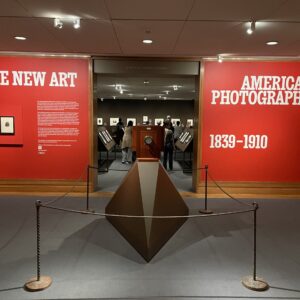JTF (just the facts): A total of 43 large scale color photographs, framed in white and unmatted, and hung against, white, grey, and light brown walls in a series of connected gallery spaces on the second floor of the museum. All of the works are archival pigment prints, made between 1978 and 1987 and printed in 2022 or 2024. The prints are each sized 42 x 52 1/2 inches, with no edition information provided. (Installation shots below.)
A revised edition of American Prospects was published by Steidl in 2023 (here). Hardcover (30.5 x 25.3 cm), 108 pages, with 52 images. (Cover shot below.)
Comments/Context: In the ever more frantic and distracting search for the fresh, new, and innovative in contemporary photography, we sometimes simply forget just how impressively resonant most of the classics actually are. Prior to seeing this show of Joel Sternfeld’s American Prospects work from the 1970s and 1980s, I fully assumed that I knew what I was going to see – this project is rightfully famous as a linchpin in the history of color photography in America, and many of its images are easily remembered without much prompting. The firefighter picking out a pumpkin while a house burns in the background? The exhausted escaped elephant being watered down by the local police? The lonely basketball hoop out in the middle of the Arizona desert? I can picture each one with little effort, and I expect many readers here can do the same. And I’ve had a copy of the photobook version of American Prospects in my library for many years, and at this point, it feels more like a reference book (with its much used and frayed dust jacket) than an artistic expression.
So my trip to the Bruce Museum to see this exhibit initially felt somewhat dutiful or even perfunctorily nostalgic, like a show I should see, rather than one that held much possibility for surprise. Perhaps I would wander its galleries, tick off the many celebrated images as though on a mental checklist of familiar friends, and then call it a day, without being forced to think all that much. But I’m pleased to report that I was entirely wrong. American Prospects jolted me again and again, in ways that are worth considering further.
The first thing that felt entirely unexpected was just how cleverly funny the photographs consistently are. Funny comedic, funny ironic, funny absurd, funny strange, funny ridiculous, funny surreal, funny bleak, and funny biting in different instances, but surprisingly witty as an underplayed artistic point of view. There’s a kind of subtle comedy to be found nearly every frame on view in this show: the baby in the playpen while the rest of the family looks over the edge of the dam, the football team practicing on an entirely dirt field, the Wet’n’Wild wave park backed by the waterways of Orlando, the glacier receding from the Majestic View Estates development sign, the lily pad solar panels on the swimming pool, the vacant expression of the kid sitting on the hood of a car, the whales dying on the beach, the guys watching the bikini contest, the rocket in the parking lot, the man in the t-shirt watching the Space Shuttle arrive, the white stretch limo parked near the mountain vista – it’s a view of America that sees the pervasive contradictions between its aspirations and its realities.
Sternfeld’s perspective on the United States wasn’t as overtly dark and caustic as Robert Frank’s had been, nor as neutral and dispassionate as that of most of the New Topographics photographers, but instead settled into a zone of skeptical uneasiness, where the ironic cracks in suburban theme-park America of the late 1970s and early 1980s could be identified and quietly highlighted. Sternfeld’s pictures are deliberately filled with subtle tensions that, when seen in aggregate, become a kind of social commentary, the simmering malaise of the American psyche of that particular historical moment laid bare.
The second observation that captivated me when seeing American Prospects again was Sternfeld’s unexpected answer to the age old photographic question of where to put the camera. Sternfeld’s views are consistently stepped back quite far, and elevated just a bit, so that we are in most cases essentially looking down at a wide expanse of landscape, with mountains, hills, forests, beaches, suburban developments, horizon lines, and big skies in the background and some kind of activity in the foreground. Taking a cue from centuries of painting, his compositions locate us in a vast space, and then entertain us with vignettes and tiny narratives that take place against that backdrop.
At the time, Sternfeld’s choice of an 8×10 view camera was somewhat radical, in that almost everyone else was making American street photography with smaller more mobile hand held cameras; Sternfeld reached all the way back to the traditions of the 19th century survey photographers for their broad sweep of landscape seeing, and then grafted those aesthetics onto the compositional structures of painting and the subtly ironic storytelling requirements of the 20th century. His results fundamentally disrupted “landscape photography” in an innovative way, paving the way for the Dusseldorf Germans like Andreas Gursky and Thomas Struth to amplify the scale in such “tableaux” even farther in the following decade.
So many of Sternfeld’s images from this body of work offer small discoveries to be made, long after we have taken in the larger scene he has presented – the fallen car after the flash flood, the women’s bathroom in the rocket parking lot, the abandoned refinery about to be drenched by a storm in the distance, the refrigerator filled with food after a tornado, the old pickup truck named Kathy, the three domestic workers waiting for the bus amid the manicured lawns of suburban Atlanta, the toy construction trucks working a dirt pile near a new housing development, the guys fixing an old tractor (and the moose horns on the truck) in Alaska. Sternfeld situates these stories in the modern American landscape, and then uses them to realign our assumptions about the kinds of unexplored visual beauty and harmony he might be offering.
My third “new” realization about Sternfeld’s work comes in the area of how he uses color. As one of the pioneers of American color photography, Sternfeld is historically grouped with William Eggleston, Stephen Shore, Joel Meyerowitz, and others who brought color photography out of the commercial realm and into the fine art realm in the 1970s. But what I had forgotten was how Sternfeld’s palette was markedly different than that his contemporaries – we routinely remember the saturated colors of those artists, and how they used those pops of color to boldly rebalance their compositions (their pictures weren’t just black-and-white photographs made in color, but an entirely different way of seeing color as its own compositional component). But the red clay brown and light grey walls of this exhibit should have been a signal – Sternfeld’s colors are much more muted and understated (almost desaturated in some cases), with many compositions built on the nuanced interplay of those quieter tones. There is no Eggleston “red ceiling” or Meyerowitz seething neon to be found anywhere in this body of work; instead Sternfeld tends to see the American landscape in unassuming natural ranges of painterly color, where softer brown, green, blue, and yellow tend to dominate.
This is particularly true when Sternfeld turns his attention to the fading relics of industrialization, like rusty factories and faded mills in West Virginia and Pennsylvania, and an abandoned freighter stranded on a sandbar in Alaska – in each case, age has muted the palette and Sternfeld celebrates that rich settling of colors. But that same instinct toward understatement stretches seasonally from the potato fields of Maine to the new housing developments of suburban California and Oregon, the grandeur of the nation’s classic beauty turned down a notch or two to match Sternfeld’s larger study of the shifting American mood. When looking at a single image, or in flipping through the photobook one picture at a time, this broader color strategy might not be readily apparent, but when seen hung in relatively intimate gallery spaces, the pictures make clear just how intentional and consistent this exhausted palette was.
I suppose it is easy to say I was impressed with a body of work that has already been rightly celebrated for decades, but my trip to this exhibition felt like a “seeing it again for the first time” kind of moment. With fresh eyes, Sternfeld’s humor, his camera position, and his color palette all seemed to shout out at me, when none of those factors would have been front and center in my mind beforehand. Proof positive that great bodies of work continue to speak to us over time, and that we glean richness (and education) from them in layers as time passes and our own eyes change.
Collector’s POV: Since this is a museum exhibition, there are of course no posted prices. Joel Sternfeld is represented by Xippas in Paris (here) and Buchmann Galerie in Berlin (here). His work is generally available in the secondary markets, particularly his most notable images, which have been printed in editions of 50 or even 100. Recent prices have ranged between $2000 and $100000, with his most famous pictures generally in a zone between $10000 and $30000.



























